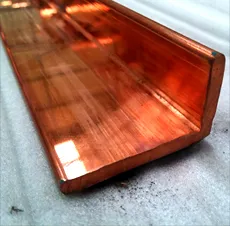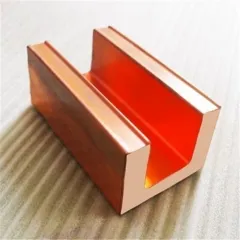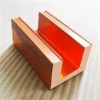Overview Of copper extrusion
Copper extrusions are solid straight strips with a certain cross-sectional shape and size after plastic processing materials with certain strength and toughness. Special-shaped copper bars are relative to common copper bars. The cross-sectional shape is not square or rectangular. There are various shapes, such as “L” type, “T” type, trapezoidal type, and multilateral polygonal type. Most of them are based on the manufacturer’s specific product design requirements.
Advantages of copper extrusion
Copper extrusions have good electrical conductivity, thermal conductivity, corrosion resistance and processability, smooth surface without wire drawing, precise size, high mechanical properties, high copper content, low oxygen content, dense structure, and free supply length.
Strong corrosion resistance: The surface of the copper profile has a layer of oxidation-resistant, corrosion-resistant copper layer, which can maintain a stable structure during application and is not easy to corrode.
Mechanical properties and good properties: copper extrusions have good mechanical properties and good properties, which can meet the needs of different applications.
Price stability: the price of copper extrusions is determined by the market, the market reflects the value of copper extrusions as tangible goods-related services. Copper on the market can bring great benefits to people’s lives, and its service costs have become more obvious, so the price has become more reasonable.
Application of copper extrusion
Copper extrusions have a wide range of applications in several fields.
In the field of electricity, copper extrusions are used as conductors for cables and wires because of their good electrical conductivity and corrosion resistance. In the field of light industry, copper and its alloys are used in the manufacture of a variety of light industrial products, such as brass, nautical brass, bronze, phosphor bronze, and white copper. In the field of machinery manufacturing, copper and its alloys are used in the manufacture of various machine parts, such as bearings, gears, pistons, pumps, and so on. In the field of construction industry, copper and its alloys are used in the manufacture of various architectural decorative materials, such as copper plates, copper pipes, copper windows, etc. In the field of defense industry, copper and its alloys are used in the manufacture of various military equipment and weapons, such as tanks, fighter jets, warships, and so on.
In addition, copper extrusions are also used as a variety of guide raw materials, such as cable rolled steel, etc., as well as used as resistance welding raw materials.
In short, the copper profile is a versatile material in different fields that can play its unique advantages.
Company Profile
Copper Channel is a trusted global chemical material supplier & manufacturer with over 12-year-experience in providing super high-quality carbides and relatives products.
The company has a professional technical department and Quality Supervision Department, a well-equipped laboratory, and equipped with advanced testing equipment and after-sales customer service center.
If you are looking for high-quality copper extrusion, please feel free to contact us or click on the needed products to send an inquiry.
Elemental Content of Raw Materials in Each Grade
| Item | T1 | C11000 | C10200 | C10300 | C12000 | C12200 | |
| Element content | Cu+Ag(≥) | 99.95 | 99.9 | 99.97 | 99.95 | 99.9 | 99.9 |
| P(≤) | 0.001 | 0.002 | 0.002 | 0.004-0.012 | 0.015-0.04 | ||
| Bi(≤) | 0.001 | 0.001 | 0.001 | 0.001 | 0.002 | 0.002 | |
| Sb(≤) | 0.002 | 0.002 | 0.002 | 0.002 | 0.002 | 0.002 | |
| As(≤) | 0.002 | 0.002 | 0.002 | 0.002 | 0.002 | 0.005 | |
| Fe(≤) | 0.005 | 0.005 | 0.004 | 0.004 | 0.01 | 0.05 | |
| Ni(≤) | 0.002 | 0.005 | 0.002 | 0.002 | 0.005 | 0.01 | |
| Pb(≤) | 0.003 | 0.005 | 0.003 | 0.004 | 0.005 | 0.005 | |
| Sn(≤) | 0.002 | 0.002 | 0.002 | 0.002 | 0.002 | 0.01 | |
| S(≤) | 0.005 | 0.005 | 0.004 | 0.004 | 0.005 | 0.005 | |
| Zn(≤) | 0.005 | 0.005 | 0.003 | 0.003 | 0.003 | 0.003 | |
| O(≤) | 0.02 | 0.06 | 0.002 | 0.003 | 0.01 | 0.01 | |
Characteristics of Each Grade Material and Application field
| Item | Characteristic | Fields of application |
| C11000 | It has good electrical conductivity, thermal conductivity, corrosion resistance and processing properties, and can be welded and brazing. Impurities containing reduced electrical and thermal conductivity are small, and trace amounts of oxygen have little effect on electrical conductivity, thermal conductivity and processing properties, but it is easy to cause “hydrogen disease”, and it is not easy to process (annealing, welding, etc.) and use in a high temperature (such as 370 °C) reducing atmosphere. | Used in electrical, thermally conductive and corrosion-resistant equipment. Such as: wires, cables, conductive screws, detonators for blasting, chemical evaporators, storage devices and various pipelines |
| C10200、C10300 | It has high purity, excellent electrical and thermal conductivity, no “hydrogen disease” or very little “ammonia disease” (no hydrogen embrittlement), good processing performance and welding, corrosion resistance and cold resistance | It is mainly used as electric vacuum instrumentation devices, various hardware products, lamps, pipe fittings, zippers, plaques, rivets, springs, settlement filters, etc |
| C12000 | Its welding performance and cold bending performance are good, generally no “hydrogen disease” tendency, can be processed and used in a reducing atmosphere, but not suitable for processing and use in an oxidizing atmosphere. The residual phosphorus content of C12000 is less than that of C12200, so its electrical and thermal conductivity is higher than that of C12200. | It is mainly used in pipes, but can also be supplied as plates, strips or rods and wires. Used as gasoline or gas transmission pipes, drain pipes, condensation pipes, mine pipes, condensers, evaporators, heat exchangers, train car parts. |
FAQ
What is a copper extrusion?
Answer: Copper extrusion is a process of processing copper or copper alloys into specific shapes and sizes through an extrusion process. It utilizes the strong pressure of the extruder to pass copper materials through the mold to form the desired shape, such as bars, pipes, profiles, etc.
What are the advantages of copper extrusion?
Answer: Copper extrusion has many advantages, including high production efficiency, stable product quality, high dimensional accuracy, and good surface smoothness. The extrusion process can also achieve continuous production and is suitable for large-scale production needs.
What fields does copper extrusion apply to?
Answer: Copper extrusion is widely used in fields such as electrical, electronic, construction, and transportation. It can manufacture various products, such as wires and cables, radiators, pipes, connectors, etc., to meet the needs of different industries for copper materials.
What is the production process of copper extrusion?
Answer: The production process of copper extrusion includes steps such as preparing copper materials, heating, extrusion, and cooling. Firstly, select the appropriate copper material and perform pre-treatment. Then, heat the copper material to an appropriate temperature to increase its plasticity. Next, place the heated copper material into the extruder and squeeze it through the mold. Finally, cool and post-process the extruded product.
How to choose the appropriate extrusion mold?
Answer: Choosing the appropriate extrusion mold is crucial for copper extrusion. We need to consider factors such as the shape, size, precision requirements of the product, and the performance of the extruder. The design of the mold should be reasonable to ensure a smooth extrusion process and stable product quality.
What are the quality control aspects of copper extrusion products?
Answer: The quality control of copper extrusion products mainly includes dimensional accuracy, surface quality, material properties, and other aspects. Through strict process control and testing methods, ensure that the product meets relevant standards and customer requirements.
How to solve the environmental issues of copper extrusion?
Answer: In the production process of copper extrusion, environmental protection issues must be considered. Environmentally friendly extrusion processes and materials can reduce emissions of exhaust gas, wastewater, and solid waste. At the same time, they strengthen the recycling and reuse of waste and reduce resource consumption and environmental pollution.




